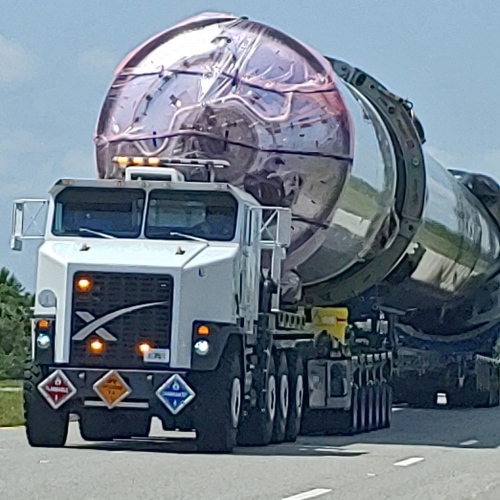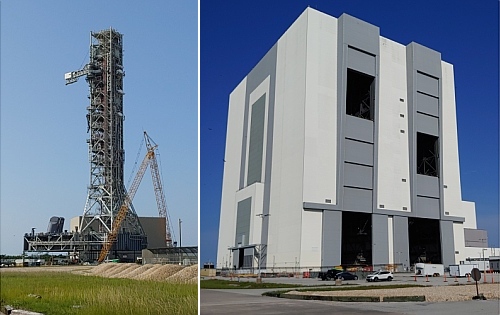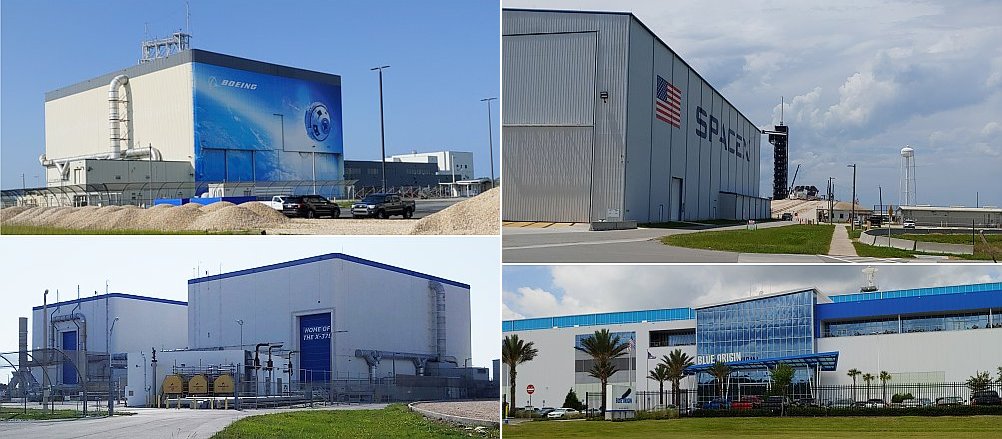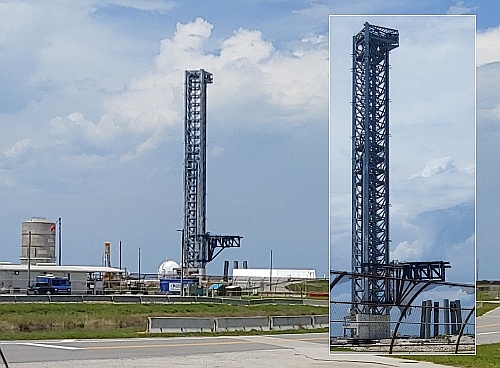Cape Canaveral, version 2.0

Falcon 9 first stage hauled back to the cape after launch
Last week BtB’s intrepid stringer Jay was unable to send me any “Quick Space links” because he was working at Cape Canaveral at the Kennedy Space Center, involved in a project involving, as he noted, “infrastructure,” giving him only a limited access to the center.
He did however have time to drive around and take pictures. For example, we have the picture on the right. On his way to lunch on his second day there he “had to pull over for a semi carrying something large. At first I thought it was a fuel tank, but it was the first stage of a Falcon-9 that lifted off on June 4th.”
This picture alone illustrates how things have changed at Kennedy since the retirement of the shuttle in 2011. Then, local officials and NASA managers all thought the sky was falling in, and that the economy of Cape Canaveral was about to die forever with that retirement.
Instead, it is now entirely routine for a private rocket company to drive its used first stages back and forth in between launches. Cape Canaveral hasn’t died, it has been reborn.
More pictures by Jay are below, all of which illustrate the resurgence of space activity that private enterprise is bringing to America’s first spaceport. To quote Jay,
The pictures I am showing are from outside the fences, I did not take any photos inside the fences. The last time I was at KSC was to watch the launch of STS-120, Discovery, in 2007. It has been sixteen years and it has changed, for the better.
I was able to schedule the work done between launches last week. Normally NASA does not want any changes done on site when a launch is scheduled for that day. I flew in Monday to Tampa and drove over to Titusville. The hotel is new and is very pro-space with their decorations. I also noticed a new Boeing/Lockheed office before the hotel.
On Tuesday I received my security badge at the ID Office from two very nice ladies. It is a rarity to find that at government facilities.
It was shortly thereafter that he saw that Falcon 9 first stage being driven down a roadway, as if it was nothing more than an ordinary truck delivery. In fact, what makes it significant was that it was an ordinary truck delivery.

Shortly thereafter, after his lunch, he got to see some of Cape Canaveral’s old space infrastructure.
I saw the mobile launch platform that was used for SLS [on the left]. They were conducting repairs on it. I proceeded by the VAB and there was construction going on. I did ask if there were any SLS components inside, but I was told that it is empty. Here is a photo [on the right] I took with some of the panels open. That is to help the workers keep cool, or at least get a breeze.

The four pictures above are the new commercial operations that now dominate Kennedy, instead of NASA. The two on the left are controlled by Boeing. As Jay describes,
Nearby the VAB are the old shuttle orbital processing facilities [bottom left]. They have new names now, I forgot what they are called now, but Boeing leases them for Starliner and the X-37B.
The top left shows Boeing’s Starliner processing facility. O if only it would get its act together and begin launching!
The top right picture is SpaceX’s Falcon 9/Falcon Heavy launch facility. From Jay:
So I got my work done early on Wednesday and I was told that I can drive around and check out the sites. I saw the Hanger-X of SpaceX, but I wanted to see pad 39A. I was surprised how close I got.
You can see that launchpad in the background.
The bottom right picture is Blue Origin’s facility, located right behind the visitor center. To repeat: O if only it would get its act together and begin launching!

Finally, to the right are two pictures of SpaceX’s new but still under construction Superheavy/Starship launchpad, with its giant tower and chopsticks for catching Superheavy on its return.
Once again, it is amazing how close to SpaceX facilities it lets ordinary people get. Jay simply had a pass to go inside Kennedy, not to get inside any controlled areas. Yet he got this close. As for other facilities:
So I went to see the other launch complexes, but I was turned around by security on the road. Turns they locked it down for the Vulcan static firing. I wandered by the airstrip, headed back in and saw a ham radio antenna. They have a club there with the callsign N1KSC.
Jay might have also gotten us some pictures of the shuttle Atlantis, which is on display at Kennedy. However,
On Thursday, I dropped off my security pass and headed down south to catch my flight. I had some time to kill so I thought about seeing the shuttle Atlantis, but they were asking a lot and I did not want to pay to park. What a racket.
His final thoughts about this first visit in sixteen years however match mine:
So driving south, I saw new buildings for engineering firms. Some are old and some are new faces to the scene. When I was at KSC in 2007, I met with a retired engineer who worked with Apollo, Skylab, and the first shuttle missions. I asked him where are all the companies? I was told that that it is not worth it. Now, everyone wants to have their offices near KSC, private enterprise has breathed new life to the local economy and to KSC. What we are seeing is KSC 2.0.
Actually, what we are seeing is KSC version minus 2.0. This new version, based on private enterprise and private ownership and not a government-run program, harks backwards, to the basic American vision that built the country. For a half century following Apollo we decided to emulate the Soviet Union and the communists, making our space effort a government program, ruled from above with no freedom or competition allowed.
The result was a moribund space program that got little done, and strived to make what it did as boring as possible.
That model has at last been abandoned. Now we have private companies competing for profit, and the result has been the most energy and creativity in the aerospace industry in decades. The situation Jay saw at Kennedy simply reflects that.
On Christmas Eve 1968 three Americans became the first humans to visit another world. What they did to celebrate was unexpected and profound, and will be remembered throughout all human history. Genesis: the Story of Apollo 8, Robert Zimmerman's classic history of humanity's first journey to another world, tells that story, and it is now available as both an ebook and an audiobook, both with a foreword by Valerie Anders and a new introduction by Robert Zimmerman.
The print edition can be purchased at Amazon or from any other book seller. If you want an autographed copy the price is $60 for the hardback and $45 for the paperback, plus $8 shipping for each. Go here for purchasing details. The ebook is available everywhere for $5.99 (before discount) at amazon, or direct from my ebook publisher, ebookit. If you buy it from ebookit you don't support the big tech companies and the author gets a bigger cut much sooner.
The audiobook is also available at all these vendors, and is also free with a 30-day trial membership to Audible.
"Not simply about one mission, [Genesis] is also the history of America's quest for the moon... Zimmerman has done a masterful job of tying disparate events together into a solid account of one of America's greatest human triumphs."--San Antonio Express-News


I seriously doubt it will ever happen, but the US Gov should consider privatizing the non-USSF portions of Kennedy.
Bob, I know you have already answered the question about SpaceX building a launch site outside of the US. But, considering the very friendly and respectful reception Elon gets from nation leaders around the world, is it possible for SpaceX to form a wholly owned foreign subsidiary and have it launch Starship from somewhere outside the US?
Steve,
They would never allow the transfer of that technology to another country. Please look up ITAR (International Traffic in Arms Regulations) Law. The law will explain why and list the technologies that we cannot sell to other countries, unless you go through a lot, and I mean a lot government hoops.
Ukraine: ‘Space Port Biden’ might be an easy sell.
“… They would never allow the transfer of that technology to another country. Please look up ITAR (International Traffic in Arms Regulations) Law. The law will explain why and list the technologies that we cannot sell to other countries, …”
yeah, I just do not see the connection between a private company investing its money to develop a rocket engine and national security. But if the EU were to allow SpaceX to build an orbital launch pad at the ESA Spaceport, how/why would the US object?
Steve: SpaceX actually tried that early in their development cycle for Falcon. Their first couple of launches were from a launch pad in the Kwajalein Atoll in the Marshall Islands.
The short version is that having to build the rocket, then disassemble it, send the stages to Kwaj by barge, then reassemble the rocket, test everything again, and launch it took a lot of extra time and effort, and introduced new points of failure to the launch process.
With SpaceX’s emphasis on iterative hardware testing, it proved too cumbersome, and they learned their lesson and stopped doing it.
STS-120, Discovery, in 2007
I was there for that launch as well. Bucket list item. You know about the heat energy involved, but you don’t think about the sound energy. At six miles away, 30 seconds after it lights (and you’re now looking well into the sky), the roar hits. For a number of seconds you feel your insides vibrating. They told us that the sound energy is lethal at 4200′, where the heat energy only lethal to 2600′.
And ahead of this truck should be a Pilot Car with the Flashing Amber Lights and Wide Load/Oversized Load Following sign on top
Steve,
Rockets can be made into ICBMs. Some technologies can be used for war. I encourage you to read up on ITAR.
Keith Pearson,
That was on my “To-Do List” as well. I was at the visitor center when it went up. My friend who I met up with for dinner told me there are better sites to watch the launch. It was still cool none the less. I felt the rumble in my feet and I will never forget that.
Star Bird,
Yes they were there, escort vehicles front and back. I only wanted a good photo of the Falcon-9. When it passed, it was very big, and the photos only showed the sections of the rocket.
“… Rockets can be made into ICBMs. Some technologies can be used for war. I encourage you to read up on ITAR. …”
Jay,
explain Rocket Lab. They are US based, in Virginia. Yet they launch from New Zealand. I read the launch site is FAA approved. Which is kind of weird. Just that I doubt that Biden and Bernie Sanders can block launches from New Zealand like they can from Texas or KSC.
”explain Rocket Lab. They are US based, in Virginia. Yet they launch from New Zealand. I read the launch site is FAA approved. Which is kind of weird. Just that I doubt that Biden and Bernie Sanders can block launches from New Zealand like they can from Texas or KSC.”
1) For the record, Rocket Lab is based in Long Beach, California, though they do launch out of Virginia.
2) Rocket Lab has an export license from the federal government for every part, assembly, drawing, engineering analysis, process, procedure, specification, and email referencing the above before they export it. This includes both sending it to New Zealand and allowing a New Zealand national to view it, even if he resides in the United States.
It is possible to combine exports onto a single license, but each individual export must still be logged. Yes, that means that every email sent or cc’d to a New Zealand national is logged as to date, time, recipient(s), and technical content and the logs are sent to the federal government.
3) Rocket Lab’s New Zealand launch site is under the jurisdiction of the American FAA, and all launches from it require a launch license (separate from the export license) from the FAA before launch. Part of the launch license is providing the documentation proving that each individual payload has the required export and launch licenses. The New Zealand parliament passed special legislation granting the American FAA jurisdiction over the launch site, which under the Outer Space treaty would normally fall under New Zealand authority.
It’s not that you *can’t* export ITAR-related technology, it’s that you need the federal government’s permission to do so. You end up needing all of the same government authorizations as launching from the US and more, so moving your launch site out of the country does’t help you.
Keith P,
I have no particular reason for making this post, other than to share your experience in a fellowship kind of way.
I was a teacher who managed to obtain press credentials to cover the first launch and landing of the Shuttle from KSC and Dryden.
I recorded audio and photos and later produced a multimedia presentation that for the next year was traded for free meals at Kiwanis, Rotary, etc., etc, kinds of groups. Lunches & dinners aplenty.
That year I had almost no grocery expenses.
Of the launch, the loudest lawnmower I’d ever heard.
“… You end up needing all of the same government authorizations as launching from the US and more, so moving your launch site out of the country does’t help you. …”
good info – thank you. The Biden admin has a limit on launches per year from Boca. And now the FAA is being sued by environmental groups to get them to prevent another Starship launch. None of these restrictions would apply to SpaceX in New Zealand. Or across the border in Mexico.
No one has ever asked Elon if SpaceX would have continued the rapid Starship launch cadence after SN15 – 7 Starship tests from Aug 2020 to May, 2021 – if not for the FAA PEA halt . My point being, Starship development would be further along if they were launching from a foreign country. Still under FAA control. But otherwise regulated by the host country.